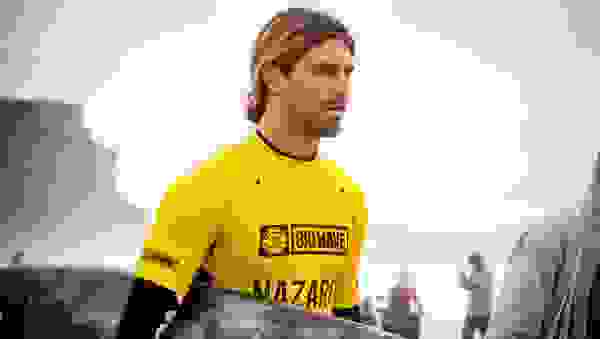For several minutes on the live broadcast of Tuesday’s Nazaré Tow Surfing Challenge in Portugal, commentators Pete Mel and Ben Mondy thought they were watching the event’s water-safety team attempting to retrieve a piece of jet ski that had broken off following a horrific mishap in the 40-foot-plus surf. When the cameras finally got a clear shot, however, it suddenly became apparent that it wasn’t plastic the swimmers and drivers were frantically trying to grab but Portuguese big-wave surfer Alex Botelho. “It’s a body,” said Mel, a veteran big-wave surfer himself, before falling silent as the dramatic, minutes-long rescue unfolded in real time.
It was around 3 P.M. local time, and the inaugural World Surf League tow-surfing contest at Portugal’s world-record-breaking wave at Praia do Norte (North Beach), Nazaré, was supposed to be finished. But because conditions remained pristine and huge, the event’s directors had extended the contest by two additional one–hour heats. (The original schedule was for four hourlong heats.) By this point in the day, every one of the event’s 19 competitors—17 men and two women—had ridden some of the biggest waves ever seen in a WSL competition, and there was little interest from the competitors, commentators, or fans in ending such a historic contest. But as the final heat began, there was plenty of chatter on the broadcast about the fatigue of surfing in such extreme conditions for six straight hours.

With about 30 minutes left in the competition, the frequency of the swell began to slow down, giving the commentating team time to reflect on the impressive work by the water-safety team throughout the day. Despite some close calls, it expressed relief that everyone in the water had remained safe. “This [event] is a proof of concept for the WSL,” said Scott Eggers, the WSL’s Big Wave Tour safety manager, in an on-air interview. “So far, so good.” Eggers went on to describe the difficulties of holding a surf contest at Nazaré. “Every wave has their challenges,” he said, but at Nazaré, “there’s so much chaos out here that it’s very unpredictable.”
Ten minutes later, the first live footage appeared of the capsized and abandoned jet ski manned by Botelho and Nazaré pioneer Hugo Vau, his Team Portugal tow partner. Mel, understanding the urgency of a ski without its driver and surfer, immediately began questioning where they were at and if they were safe. His worst fears were soon realized, as members of the water-safety team tried to pull Botelho’s seemingly lifeless body from the ripping current just off the beach.
For those who know Nazaré intimately, especially Tuesday’s competitors, the accident was a worst-case scenario. Botelho and Vau were attempting to make it back out to the lineup, but when they tried to punch through Nazaré’s notoriously difficult-to-navigate inside section, they met head-on a mountain of whitewater that launched the ski vertically, catapulting both men into the air. Ask any surfer who’s been caught in this area of Nazaré on a big day, and they’ll tell you there’s no more violent or powerful place to find oneself. Vau, the driver, appeared to fall directly, and hard, on top of the jet ski, while Botelho, who had been hanging on to its rescue sled, was sucked up and pitched over the lip of the wave, before vanishing beneath the water.
When it became apparent that the situation with Botelho and Vau was potentially life-threatening, competition was suspended and live images of the rescue were eventually cut off, as is protocol in most extreme-sports broadcasts. But people privy to radio communications from the rescue crew on the beach told Outside that Botelho remained unconscious and without a pulse for about a minute after he was finally pulled from the water. (Those sources wished to remain anonymous.) Once he was revived and transported to an ambulance, Botelho was conscious and coherent. He was rushed to the hospital and placed in intensive care. On Wednesday, the WSL issued a statement saying: “We’re happy to report that Alex remains stable.” That same day, a Surfer Today article quoted Nazaré mayor Walter Chicharro, who said he’d talked to Botelho’s doctors and that “there’s good news, even though [Alex] requires extra care and control. Alex is now breathing without any artificial aid, and he is perfectly conscious. Doctors confirmed that there’s still water in his lungs.” Outside reached out to Vau, but because “Alex is still in a critical situation,” he declined to comment further. As for Vau’s condition, which was initially described by some as a spine injury, he is “doing fine,” according to one of the event’s surfers. (The same Surfer Today article noted that Vau was to be released from the hospital on Wednesday.)
Inevitably, some in the surfing community questioned the WSL’s decision to hold live events in such dangerous conditions. “People are always going to push limits individually, and that is their prerogative,” UK surf magazine Carve wrote on Tuesday. “Still the bigger questions is [sic] how far are the WSL, as a commercial operation, willing to go as big wave surfing comps enter a new, untested realm which is right on the limits of human endurance.” Hawaiian big-wave surfer Albee Layer was more succinct: “Our lives are clickbait,” he wrote on Instagram. Layer sustained a head injury from a wipeout at the World Surf League Jaws Big Wave Championships in December. But others—most notably some of Tuesday’s competitors—have pointed out that riding big waves is their passion, contest or no contest. Hawaiian big-wave surfing phenom Kai Lenny, who, along with his Young Bulls teammate Lucas “Chumbo” Chianca, won the event as well as the individual Men’s Wave of the Day award, wrote on Instagram: “We surf big waves because we love it, if the contest wasn’t running we all would still be out there. I can’t wait to have another session with these legends!”
Filed To: SurfingEventsWatersportsSurvival
Lead Photo: Damien Poullenot/Courtesy WSL via Getty





Recent Comments